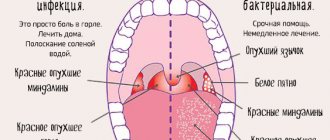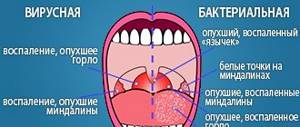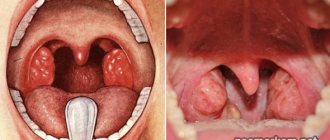How to gargle for a sore throat?
All kinds of rinses for the treatment of sore throat - with medicinal herbs, with soda or sea salt - are extremely popular among the people.
But when concerned parents ask the question: “How to gargle a child with a sore throat?” to a medical professional, they almost always hear the answer: “To treat a sore throat, nothing.” This is a medical fact - no local treatment methods - rinsing, pharmaceutical sprays with antimicrobial substances and the like - can cope with the disease or cure a child of a sore throat. Gargling for a sore throat is not a method of treatment. But it is a fairly effective way to significantly reduce a sore throat. The fact is that by gargling (in other words, constantly moistening it), the baby thereby softens the mucous membrane of the tonsils, relieving their compression.
At home, it is best to use a decoction of sage and chamomile, as well as soda or saline solutions as a rinse.
- Soda solution: 1 tsp. baking soda per glass of water;
- Saline solution: 1 tsp. table salt per 500 ml of water;
How does a sore throat hurt?
Constant companions of acute tonsillitis are increased body temperature, soreness of the tonsils, signs of intoxication in the form of weakness, increased fatigue, pain in muscles and joints. The reason for this condition lies in the pathological processes occurring in the body. As a rule, pain is caused by inflammation and swelling of the mucous membranes of the larynx and trachea.
The causative agents of the disease are streptococci, staphylococci, and less commonly, viruses and fungi. They come from the outside through contact with an infected person; can be constantly present in the body, since they are part of the opportunistic microflora; multiply when there is a focus of infection in the oral cavity in the form of carious teeth and inflamed gums. With the slightest weakening of the immune system, infectious agents multiply, release toxins, and cause the development of inflammatory processes in the throat.
The mechanism of pain with purulent sore throat consists of 2 processes:
- at the site of pathology, inflammatory mediators are released - biologically active substances that irritate pain receptors in the throat mucosa;
- the tissues of the palate, pharynx, and trachea have a good blood supply. As inflammation develops, blood flow increases, swelling occurs in the throat, and pain receptors are again affected.
The duration of the pain syndrome depends on the form in which the disease occurs:
- Catarrhal tonsillitis is a mild form in which the damage to the tonsils is superficial. First, a sore throat and a feeling of dryness appear in the throat, and later, when swallowing, a mild pain occurs that lasts 6-7 days.
- Follicular, lacunar forms are distinguished by the severity of symptoms: a sharp rise in temperature to 39-40˚. The sore throat is very intense, often radiating to the ear. The discomfort lasts 7-10 days.
- Phlegmonous sore throat is characterized by the fact that it causes a sore throat on one side. The symptom occurs when talking or swallowing. The pain does not go away until the abscess is opened and lasts about 14 days.
- The necrotic form involves necrosis of the tonsil tissue. With it, the patient does not leave the feeling of a “lump” in the throat. The pain is present and intensifies when swallowing. The necrotic form can last more than 1 month.
Do I need treatment?
Viral diseases often cause pain. The throat hurts when there is an acute respiratory viral infection, influenza and sore throat. The cause may also be bacterial. The throat may hurt due to streptococci, which the patient’s body was exposed to infection. Streptococci are contagious and, if therapy is chosen incorrectly, they can result in a number of serious consequences for the patient. The most severe stage is toxic shock.
A sore throat can also occur due to other, less obvious reasons. Why?
- Dry air in the room and a specific reaction to it.
- A sudden allergic reaction to environmental objects, including animal fur and plant pollen.
- Irritants, which include tobacco smoke and chemicals found in dishwashing detergents. Paint, furniture and more.
- Tension of the vocal cords for a long time, which can occur if you speak loudly, scream, or lose your voice.
- Digestive tract disorders.
- Neoplasms.
Sore throat is not a subject for “home” diagnostics
Indeed, a sore throat, with traces of obvious purulent inflammation, is the most striking sign of a sore throat. However, severe pain and redness in the throat can also signal other diseases. The most common ones are:
- Inflammation of the pharynx is pharyngitis.
- Inflammation of the tonsils is called tonsillitis.
Both can be of either viral or bacterial origin. Bacterial tonsillitis can be caused by different bacteria, but in the vast majority of cases it is caused by the bacterium streptococcus. It is tonsillitis caused by streptococcus (and also in some cases staphylococcus) that is called sore throat in the medical community. And all other “varieties” of a sore and red throat are other diseases, most often having nothing to do with sore throat.
However: even a red and inflamed throat with signs of a purulent infection does not always mean a sore throat! Exactly the same symptoms may indicate some other diseases - for example, leukemia, scarlet fever, diphtheria, infectious mononucleosis and some others.
We have presented this entire mini-essay just so that you, parents, can clearly see that it is impossible to diagnose a sore throat on your own, without the support of an experienced and knowledgeable doctor!
Moreover, even for professionals, sometimes just a visual inspection is not enough for a final verdict. For example, with both sore throat and diphtheria, the infected throat may look identical. In such cases, any reasonable doctor will prescribe a general clinical blood test for the child. Which will show absolutely exactly whether the child has a sore throat or another disease.
Treatment of tonsillitis: indications for tonsil removal
If one of the prerequisites for the occurrence of tonsillitis is the very presence of tonsils (they are also tonsils), then a reasonable question arises: maybe it makes sense to remove the tonsils once and for all using a simple surgical operation? If they don’t exist, there won’t be any purulent sore throats in the future?
This is true - after removing the tonsils, there will be no more sore throats. But the risk of contracting many other diseases will increase many times over. After all, the tonsils, consisting of the so-called lymphoid tissue, are “built-in” into the human larynx (namely, right “on the threshold” of both the digestive and respiratory systems) for a reason, but as special filters. In fact, most of the viruses and microbes that are harmful and dangerous to our health literally “settle” on this organ. In essence, the tonsils are the vanguard of the immune system, our primary defenders. Therefore, you need to have very good reasons to get rid of tonsils.
Every pediatrician, as a rule, knows by heart the strict medical protocol, which clearly prescribes in which cases surgical intervention for sore throat and tonsil removal is indicated.
Such situations include:
- If complications arise during the treatment of angina (or after it);
- If the tonsils, due to inflammation, have increased so much in size that they begin to close and prevent proper breathing;
- If exacerbations occur more than four times a year, requiring treatment with antibiotics;
It is very painful to swallow on one side, sore throat or paratonsillar abscess?
It only hurts on the side of the tonsil, which is visually smaller here in the photo. Pain when swallowing increased gradually over 2 days. There is a temperature, but I feel that it is not high.
With such asymmetrical pain, it is most likely an abscess.
Moreover, a low temperature indicates that inflammation is limited. A sore throat would produce a fever of at least 38°C.
I literally had a similar abscess break out the day before yesterday. The intense bursting pain and intoxication (weakness, malaise, chills, followed by a feeling of heat) immediately passed. And before that, for six days I could neither swallow nor speak. The temperature was no higher than 37.4.
Whether or not to contact an ENT specialist at this stage is up to you. One thing is clear: at the stage of abscess formation, at the stage of infiltration (there is no abscess cavity yet), you cannot open it or poke it with anything at all. This is ineffective and dangerous.
Gargling with antiseptics never hurts. This will at least partially remove inflammation and soften the mucous membrane (for example, you can steam filter bags with sage). And also spray with inhalipt or kameton.
In general, in the future you should regularly see an ENT specialist. The size and condition of the tonsils reflect chronic inflammation (tonsillitis).
Maintaining a consistently healthy throat is a lifelong endeavor.
Your throat hurts a lot – coronavirus or not?
Does a person have a sore throat due to coronavirus? Yes, most often in the first days of the disease. A sore throat begins along with an increase in body temperature. The patient may also experience general weakness, fatigue, nasal congestion and a dry cough with sputum discharge. It is important to understand that the new virus can also be asymptomatic.
How does a sore throat hurt with coronavirus? With Covid-19, sore throat can be different. Here are the most common:
- Pain when swallowing.
- Slight burning in the throat.
- Dryness.
- My throat itches.
Sore throat and runny nose - coronavirus or cold? These symptoms are not unique. If a person has a sore throat and runny nose, it is most likely a common cold. But it is very important to monitor your condition. And if you have other symptoms of Covid-19, contact your doctor immediately.
Sore throat, painful to swallow, but no fever
If pain and soreness appear, but there is no fever, you should exclude sore throat and flu from the list. There are diseases that provoke pain without fever:
- Ligament strain. If the patient experiences stress on the vocal cords constantly, diseases such as pharyngitis and laryngitis may develop. People who choose a creative profession often suffer from such ailments.
- Allergy. In this case, the pain will be accompanied by severe soreness. The patient may have difficulty swallowing. A sensation of a lump in the throat and dry mouth. The most basic symptoms are rash and itching on areas of the skin. It is necessary to initially avoid allergens to improve the patient's well-being.
- Poor environment, addiction to smoking. The immune system can be greatly weakened by constant inhalation of industrial emissions and exhaust fumes by the patient. The disease may resemble an allergic reaction in its symptoms. Smoking can also cause a sore throat, which is due to the dried out casing.
- Gastrointestinal diseases. The release of gastric juice can reach the pharynx. One of the causes of pain can be heartburn and increased acidity.
Causes of recurrent sore throat
In fact, there are quite a lot of reasons, here are the main ones:
- The sore throat has entered the chronic stage. This is the most likely reason that you have a sore throat again after a recent sore throat. In fact, it only seems that chronic tonsillitis is a disease that takes years to develop. In practice, everything is much simpler. Serious changes in the structure of the tonsils can occur simply because the tonsillitis that you previously suffered was very severe and caused serious complications. As a rule, chronic tonsillitis is marked by constant, but mild pain in the throat and sometimes a low-grade fever may occur. However, the main danger that this chronic disease poses is the possibility of unexpected exacerbations at any time of the year and the risk of serious complications.
- Another reason why your throat hurts after a sore throat is a new infection. If your immune system is weak enough a few weeks after a sore throat, you can easily catch pharyngitis, laryngitis, or simply another form of acute tonsillitis. No special treatment is needed in this situation. Just go to an appointment with a therapist and start treating your illness all over again.
- A sore throat may appear as a result of postanginal complications, for example, dysfunction of the thyroid gland or something else.
Sore throat, painful to swallow: causes
Often the cause of a sore throat is prolonged exposure to cold air. Human inhalation is accompanied by the inhalation of a large number of harmful microbes.
Defender cells neutralize the emerging infection. Disposal of individual microbes does not negate the massive attack of viral bacteria, which causes inflammation and pain.
Reasons why pain may occur:
- Viral infection. Often accompanied by a runny nose. The patient experiences a feeling of dryness in the mouth, and the larynx burns sharply. When swallowing, the pain intensifies so much that headaches also appear. It can be painful when diseases such as influenza and chickenpox occur. Worsening of the disease leads to complications.
- A foreign body cuts the throat. When you swallow a foreign object, your throat becomes irritated. The pain is getting worse. The object can scratch the shell, causing the patient to experience discomfort.
- Allergic reaction. The process is triggered by allergens and inflames the mucous membranes of the nasal and oral cavities. Irritation causes pain in the patient. The danger of the pathology is explained by allergic attacks, which carry serious negative consequences.
- Colds. When a patient coughs frequently, the disease is accompanied by a runny nose and high fever, and sores may appear. In this case, you need to resort to special drugs that reduce pain.
- Angina. The tonsils become inflamed, the patient has a sore throat. There is a sensation of a lump lodged in the throat area, which makes it difficult for the patient to swallow.
Not just a sore throat. What is the cause of a sore throat?
Sore throat is one of the most common complaints. Usually it is acute, because long-term, aching pain is much less common. The most common cause of this symptom is viral pharyngitis - inflammation of the pharyngeal mucosa.
Our expert: therapist, family doctor Evgeniy Likunov.
Cuts, stabs, aches, presses?
Typically, a sore throat is permanent, worsens when swallowing, and may be the only complaint when visiting a doctor. Although it often occurs against the background of general symptoms characteristic of acute respiratory infections, such as weakness, malaise, fever, headache, runny nose.
There is a wide variety of pain in the throat - from sharp, “dagger”, stabbing, cutting to dull, aching, pressing; from bursting to pulsating or mixed, with a constant, increasing or subsiding character. The localization of pain is also different: it can hurt in the middle, on the right or left, on both sides or all over the throat.
Lozenges: tasty, but useless
The appearance or intensification of pain when swallowing most often indicates a throat disease. If pain sensations do not change when swallowing, it can be assumed that they reflexively reflect a disease of a completely different organ, and then we must continue to look for the cause of the malaise. For example, a sore throat may not only be one of the early symptoms of infection, but also a late symptom of a tumor.
That is why you cannot endure a sore throat, avoiding contact with a doctor, and eating various lozenges. This is not only ineffective, but also dangerous, since a serious disease may be missed.
The most common disease accompanied by a symptom such as a sore throat is sore throat, a bacterial infection that must be treated with antibiotics. It can be easily confused with viral pharyngitis, but in this case antibiotics will not only be useless, but also harmful. This is why if you have a sore throat you definitely need a doctor.
Both diseases are characterized by acute pain and hyperemia (redness) of the pharyngeal mucosa, however, with angina, a purulent coating appears, the temperature rises to high values, and there may be no other complaints, while with pharyngitis, a runny nose and other symptoms of ARVI appear.
Drinking is not harmful to health
When treating pharyngitis (as well as sore throats), it is important to drink plenty of warm fluids, and in case of severe pain, it is also necessary to use painkillers - such as Nurofen or paracetamol. Antibiotics are prescribed only if a bacterial infection has occurred and, for example, tracheitis, bronchitis or laryngitis has begun
For angina, it is necessary to use antibiotics from the very beginning of the disease. Ideally, you need to take a swab from the throat to determine the type of infection and sensitivity to antibiotics in order to immediately prescribe the most effective one.
If you do not start treating a sore throat on time, serious complications are possible that affect vital organs - kidneys, heart, joints. And sometimes, against the background of this disease, autoimmune diseases develop (scleroderma, lupus erythematosus).
And mushrooms grow in my mouth
In addition, doctors often encounter such throat diseases as:
- candidal stomatitis. This is a fungal disease in which small milky-white spots appear on the soft palate, back of the tongue, pharyngeal mucosa and larynx;
- Infectious mononucleosis. Symptoms include swollen and reddened tonsils covered with large yellowish-white films;
- herpangina (Coxsackie virus) - small blisters on the soft palate, uvula, arches, and posterior wall of the pharynx.
In these cases, a bacterial infection can also occur, an abscess begins when the uvula moves and it becomes impossible to fully open the mouth. Symptoms of severe diphtheria infection develop. For these diseases, the doctor must also select an effective antibiotic.
To the doctor!
Complaints of acute sore throat in elderly patients should be alarming. Nasopharyngeal cancer is a fairly common pathology today, which doctors have not yet learned how to treat effectively. The course of this disease is extremely aggressive and its development is rapid. The prognosis depends on early diagnosis. Therefore, in no case should you endure it until it “goes away on its own.”
Another possible reason for such complaints is that older people often use dentures. And they are a source of injury, infection and atrophy of the mucous membranes. In all cases, to rule out serious illnesses and prescribe the correct treatment, it is best to see a doctor.
How many days does a sore throat hurt with a sore throat?
Every person who has had a sore throat at least once knows what discomfort this insidious disease can cause.
Temperature, aching, difficulty breathing due to pain and swelling.
Most often, the period of sore throat is directly related to pain in the throat. Then a pertinent question arises: how many days does your throat hurt? How to speed up recovery?
What causes a sore throat
The tonsils are most often the first organ that is affected by angina. The most common cause of the disease is considered to be a successful attack on the human body by pneumococci, staphylococci or streptococci.
Children and adults are susceptible to tonsillitis (another name for tonsillitis). The symptoms are almost the same for any age. A sore throat is that ominous symptom that unites all people who are attacked by a sore throat.
The initial period of the disease is not characterized by severe pain. This is also due to the fact that the time allotted for incubation of this disease is 2-4 days.
If a person does not immediately respond with adequate treatment, then the next acute phase begins, when almost all the symptoms inherent in angina appear in a pronounced form.
This is especially true for sore throats - they become acute not only when swallowing, but constantly. The patient may feel sick, vomit and have a stomach ache.
What determines the duration of the disease?
Various factors can influence the symptoms of pain:
- Type of sore throat;
- The degree of complexity of the disease;
- How advanced is the disease?
- Age of the patient;
- The state of his immunity;
- Individual characteristics of the patient;
- The environment in which the patient is being treated.
There are general statistics by which you can find out the duration of a sore throat and, accordingly, a sore throat.
The total period of illness with proper treatment is 7 days.
How long can a throat hurt?
The root cause of sore throat may influence the duration of the disease. For example, tonsillitis of bacterial origin, if treated in a timely manner, can torment a person for about five days.
There is a danger that a sick person will cause infection to another before he recovers, that is, even if he began to be treated in a timely manner.
Therefore, it is strictly recommended to isolate the patient from other people until he is completely recovered.
With bacterial tonsillitis, the symptoms are not very obvious, so a person can ignore the presence of the disease.
When a virus penetrates a weakened body, the disease, along with a sore throat, can “linger” in a person for 2-5 days, subject to timely treatment.
Symptoms of the viral root cause of sore throat are very pronounced:
- Headache;
- Intensity of sore throat;
- Cough is tormented;
- State of nausea, vomiting manifestations;
- Discomfort in the abdomen;
- Runny nose and difficulty breathing;
- Discomfort when swallowing food or drinking;
- Presence of high body temperature.
Warning
In order to recover faster and, accordingly, get rid of pain, you should not self-medicate.
A person will not speed up the number of days his throat will hurt if he blindly rushes into antibiotic treatment, believing that they will be a means of a quick recovery.
For example, the viral nature of the disease has nothing to do with antibacterial drugs, since antibiotics are powerless against viral agents.
On the contrary, by applying the wrong treatment, a person can worsen the situation if the disease becomes more severe or if any additional pathologies are added: disease of the heart, kidneys, bones, ENT organs.
This disease is treated with analgesics, drinking plenty of fluids, rinsing, and lozenges. Treatment is prescribed by a doctor.
Why does my throat bother me again after a sore throat?
So, the sore throat was cured in 7 days, but the throat began to hurt again. What is the reason?
Relapse may occur due to several factors:
- For some reason the disease became chronic;
- Untimely, inadequate or incomplete treatment;
- An unwanted entry into the body of a new infectious agent has occurred;
- After recovery, the person, through some of his behavior, provoked complications for his weakened body.
It is chronic sore throat that is attributed to all the “accusations” when it comes to discomfort in the throat.
By the way, recurrent conditions can occur as soon as the immune system is weakened, and a harmful infection of any type is right there!
In this video you can learn more about the topic of the article:
Therefore, there is a general guide: instead of filling your home medicine cabinet with medicines, lozenges and other throat medications “just in case,” it is better to seriously strengthen your immune system, rest moderately, get enough sleep, eat well, give up bad habits and satisfy your spiritual needs.
A smart approach to treatment
In order for the number of days of sore throat to be reduced by a matter of hours, its treatment must be started promptly as soon as the first signals appear.
Of course, only a doctor can provide the most qualified advice on this matter.
No matter how well the patient or his friends understand, even the necessary folk remedies can be advised by a doctor.
In any case, the pain of a sore throat will have to be eliminated with antipyretic, anti-inflammatory and antibacterial drugs.
One clarification: you need to resort to the use of antipyretics only when the thermometer has exceeded 39 Celsius.
But the patient himself can have a positive effect on how many days his throat hurts due to any underlying cause of this symptom if he resorts to frequent and copious rinsing.
Rinsing is an effective way to deliver therapeutic agents directly to the site of inflammation.
Here's more information in the video:
Among the components of tinctures there can be both medicinal herbs and potent medications.
Rinse with apple cider vinegar, beet juice, lemon juice, mustard, soda, salt, calendula tincture, as well as pharmaceutical preparations.
Let's summarize
Sore throat is one of the most common and unpleasant sensations. It can arise due to illness, or maybe even for a banal reason: he spoke in a raised voice, for example, during a quarrel.
In addition to the treatment of the throat itself, it would be good to practice prevention in order to prevent the occurrence of diseases as much as possible.
For example, you can reconsider your lifestyle: is it time to change something?
How many days does a sore throat hurt?
Every person who has had a sore throat at least once knows how much discomfort this disease causes.
So, the patient may have a sore throat, and it is also difficult for him to swallow and breathe, due to swelling of the larynx.
But how many days will the patient have to suffer from a sore throat? And how to get rid of a sore throat?
How long does a sore throat with tonsillitis last?
In acute tonsillitis, discomfort in the throat is caused by an inflammatory process. Often the disease develops due to the fact that the body penetrates:
It is worth noting that sore throat can develop in people of different ages, no matter how old a person is, everyone has a sore throat. At the initial stage of the disease, the sore throat is not severe. Basically, the incubation period is 2-4 days.
As inflammation increases, the symptoms of the disease become more severe. In particular, this is felt when the patient tries to swallow food or drink a drink.
In some cases, symptoms such as:
How many days can a sore throat hurt with a sore throat? As a rule, the disease lasts one week. But the duration of the flow also depends on the source of its occurrence.
For example, bacterial tonsillitis lasts up to 5 days if treatment was timely. However, you can infect another person with this disease until the patient undergoes a course of antibiotic treatment.
It is worth noting that with bacterial sore throat the symptoms are very mild, so a person may not even be aware of the progression of the disease.
How long does a viral sore throat last? If a virus has entered the body, the disease can last from 2 to 5 days. The following symptoms are observed:
- headache;
- intense sore throat;
- cough;
- nausea;
- abdominal discomfort;
- runny nose;
- vomit;
- discomfort when swallowing food;
- elevated temperature.
You should not try to get rid of a viral sore throat by taking antibiotics, because they are powerless against viruses. In this case, analgesics, drinking plenty of fluids and gargling will help relieve a sore throat.
Thus, a sore throat will disappear after 7 days of drug treatment.
Why can my throat hurt again after tonsillitis?
The reasons for relapse lie in several factors:
- the disease has become chronic;
- treatment of angina was incorrect or incomplete;
- a new infection has entered the body;
- Complications appeared after the illness.
Chronic sore throat is the most common cause of discomfort in the throat. Moreover, relapses will remind themselves every time the immune system is weakened or another infection enters the body.
After therapy, the body is still weakened, so it is difficult for it to cope with new diseases. Therefore, he needs vitamins and other useful substances.
Until the body recovers completely, there is an increased risk of developing diseases such as:
In addition, after treatment for a sore throat, a sore throat may appear as a result of impaired functioning of the thyroid gland and other diseases.
What can result from not treating a sore throat?
Inappropriate or inadequate treatment leads to the following complications:
- chest pain;
- heart disease;
- rheumatism;
- swelling of the legs;
- inflammation of the middle ear;
- myocarditis;
- renal failure;
- liver or kidney damage.
To get rid of a sore throat after tonsillitis, you need to avoid hot and cold foods, gargle with a solution of citric acid, drink plenty of fluids and, of course, seek medical help and take some antibiotics for a sore throat.
Treatment
To shorten the duration of a sore throat, its treatment must be started immediately after the first manifestations appear. After all, the advanced stage of the disease requires the use of potent drugs and long-term therapy.
In addition, timely treatment reduces the likelihood of complications tenfold.
Often, if your throat hurts due to a sore throat, then the following types of medications are prescribed:
- antipyretics;
- anti-inflammatory;
- antibacterial.
It is worth noting that medications that eliminate fever should be taken if the temperature is not less than 39 degrees. Such agents include acetylsalicylic acid, Amidopyrine, etc.
To relieve pain in the throat, it is useful to drink tea with honey, chamomile, grapefruit, lemon and ginger. It is important to keep the throat moist, so the patient needs to drink plenty of fluids.
Source: https://medtehnika-plus.ru/bol-v-gorle/skolko-dnej-bolit-gorlo-pri-angine
How to treat a sore throat and painful swallowing for a child?
- An effective method of combating a sore throat is the use of Lugol's solution and sprays. The taste of the product leaves much to be desired, but the drug has a positive effect on diseased areas, curing the disease within a couple of days. The product should be used about three to four times a day. After the procedure, you must refrain from eating and drinking for an hour.
- If you have a sore throat, you should not gargle. It is possible to use soda or saline solution, eucalyptus, chamomile and propolis.
- If a small child suffers from a sore throat, you can treat the disease with medicinal lozenges and lozenges. Usually the drugs have a pleasant taste and have a beneficial effect on diseased areas.
- Used in the treatment of Lizobact in tablets. The drug is safe and has antiseptic properties. If a young patient’s sore throat is advanced, then it is necessary to take a course of antibacterial drugs.
- Possible use of antibiotics in therapy. The course lasts about a week, but antibacterial drugs have a negative effect on the stomach. Antibiotics must be taken along with drugs that help improve and restore the stomach.
//www.youtube.com/watch?v=jpZlFOveaBI
How to treat an adult's throat with a sore throat?
The easiest and fastest way to get rid of a sore throat is if you start treating it as soon as the first symptoms appear. An advanced stage of the disease requires taking more potent drugs and a longer period of therapy. In addition, treatment started on time reduces the risk of serious complications many times over. As a rule, to treat sore throat with sore throat in adult patients, doctors prescribe antibacterial, anti-inflammatory and antipyretic drugs. Antipyretics must be taken at temperatures of 39° C and above. These include amidopyrine, acetylsalicylic acid, etc.
How to treat a sore throat in an adult in order to reduce pain? Chamomile tea, tea with lemon juice, honey, and grapefruit are perfect for this. It is important to keep your throat moist at all times, so the need for plenty of warm fluids is essential. A humidifier running in the room will have a good effect - it will moisturize not only a sore throat, but also the nasal passages, helping a person to breathe more freely.
Taking painkillers such as Acetaminophen or Ibuprofen will be very helpful if the pain is severe enough to be unbearable. However, you should not overdo it with such drugs, since their excessive consumption harms the gastric mucosa.
Rinsing is a procedure that helps to wash away purulent masses and other secretions containing a huge number of pathogens from the surface of the larynx. Rinsing can significantly reduce sore throat, reduce the degree of inflammation of the tonsils and alleviate the patient’s condition. Often, the following products are used for rinsing:
- Apple vinegar,
- salty water,
- tincture of calendula,
- herbal decoctions,
- carrot or beet juice,
- hydrogen peroxide,
- lemon juice,
- mustard, etc.
My throat hurts badly: what should I do?
To avoid complications with painful sensations in the throat, it is necessary to promptly treat the cause of the disease. Local antibacterial drugs help with severe pain, destroying the source of the inflammatory process and inhibiting the proliferation of bacteria. In this case, the use of aerosols that contain antibiotics helps patients.
Doctors may prescribe you to take Bioparox, which contains natural antibacterial drugs. The product helps suppress the effects of harmful microorganisms that cause the disease and has an anti-inflammatory effect.
//www.youtube.com/watch?v=w2NOQvZqdLI
Causes of sore throat in children
The cause of sore throat is “nasty” and unpredictable microorganisms - streptococcus and staphylococcus. The ratio is approximately as follows:
- 80% of all cases of sore throat are provoked by the “activity” of streptococcus.
- 10% of sore throats are caused by staphylococcus.
- The remaining 10% occurs due to mutual influence - streptococcus and staphylococcus at the same time.
Getting (through the respiratory tract) onto the mucous membranes of the tonsils, these bacteria “settle” there and begin to actively multiply - this is where painful ulcers form on the tonsils during tonsillitis. It is these purulent inflammations that cause severe sore throat with sore throat. And it is they that outwardly distinguish angina from most other diseases affecting the pharynx and larynx.
With ARVI, the tonsils may also be enlarged in size and have redness, but there will definitely not be any abscesses there. Because, let us repeat, the very nature of these two diseases is different: for sore throat it is bacterial, for ARVI it is viral.
How long does a sore throat hurt with a sore throat?
Sore throat with sore throat, or acute tonsillitis, is caused by inflamed tonsils. The disease most often occurs due to infection of the body with streptococci, staphylococci, and pneumococci. People of absolutely all ages are susceptible to the disease - small children of preschool age, and adult men and women.
At the very beginning of the development of sore throat, the pain in the throat is not severe. The incubation period lasts on average from 2 to 4 days. As inflammation increases, the pain becomes stronger every day and becomes sharper. This is especially felt when swallowing food or drinking hot or cold drinks. Due to weak immunity, young children may also experience nausea, vomiting, and pain in the abdominal area.
How long does a sore throat hurt? Usually the period is about a week, but the duration of the disease depends on what source it is caused by. For example, bacterial tonsillitis will last less than a week if you start treating the patient in time. A person can infect someone with a bacterial form of sore throat until he takes a course of antibacterial drugs. And what’s most interesting is that the person who carries the infection may not feel any symptoms of the disease.
A slightly different situation arises when a person is infected with a viral form of sore throat. In this case, the disease can last approximately 2-5 days. The patient tends to experience the following symptoms of illness:
- severe sore throat;
- cough;
- runny nose;
- elevated temperature;
- problems swallowing food;
- as well as vomiting;
- nausea;
- pain in the abdominal area;
- headache.
Antibiotics are powerless against this form of the disease, since they have no effect on the viral infection. You can get rid of this form of sore throat by gargling, drinking plenty of warm water, and analgesics. Regular use of medications and other methods of treating viral sore throat can get rid of the disease in about a week.
What to do at home?
- Use salt water to gargle.
Microbes become less active when using a saline solution, which helps reduce the inflammatory process and heal wounds. The pain subsides due to the effects of salt water. Care must be taken to ensure that the solution does not enter the stomach, which could cause serious problems later. It will become easier to breathe after the first procedure.
- Making chicken broth.
The broth has a moisturizing effect, soothing the mucous membrane. A sip of the product will help prevent your throat from drying out. The broth also has an anti-inflammatory effect. It is necessary to drink the product while it has not yet cooled down to help reduce the discomfort of a cold.
- Making warm tea.
It is not always possible to prepare the broth, so often the patient only needs to drink a cup of warm tea to feel better. When adding honey, the tea will have an anti-inflammatory and softening effect, will help eliminate coughs, and stop itching. They often resort to chamomile tea, which moisturizes and relieves inflammation and swelling.
- Air humidity in the room.
It is necessary to ensure that humidity is within normal, optimal limits.
- Cold food.
Thanks to the cold, blood vessels constrict and swelling decreases. The inflammatory process stops and pain decreases
It is important not to overdo it so that cold food does not cause complications of the disease and dire consequences.
//www.youtube.com/watch?v=cMQ5DsgcCUk











